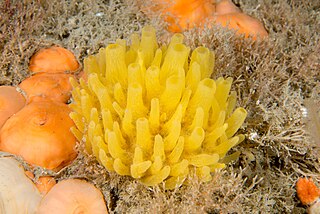
Polymastia is a genus of sea sponges containing about 30 species. These are small to large encrusting or dome-shaped sponges with a smooth surface having many teat-shaped projections (papillae). In areas of strong wave action, this genus does not grow the teat structures, but instead grows in a corrugated form.

Sycon is a genus of calcareous sponges belonging to the family Sycettidae. These sponges are small, growing up to 7.5 cm with a length from 2.5 to 7.5 cm, and are tube-shaped and often white to cream in colour. They are known to aquarium hobbyists as "Pineapple" or "Q-Tip" sponges, and are frequent "hitchhikers" accidentally brought in.

Auletta is a genus of sponges in the family Bubaridae.
Cladorhiza caillieti is a carnivorous sponge of the family Cladorhizidae described in 2014 from specimens collected from the Juan de Fuca Ridge off the coast of Vancouver Island. It feeds on small crustaceans such as amphipods and copepods. C. caillieti is an elongate, bottlebrush-shaped sponge with filaments projecting from a main stem, and ranges from 7 to 9 cm in height. The specific epithet honors Dr. Gregor M. Cailliet of the Moss Landing Marine Laboratories.

Saccocalyx is a genus of flowering plant in the family Lamiaceae, first described in 1835. It contains only one known species, Saccocalyx saturejoides, native to Morocco and Algeria.

Euplectellidae is a family of glass sponges (Hexactinellids) belonging to the order Lyssacinosa, first represented in the Ordovician fossil record, substantially older than molecular estimates of the clade's age.

Caulophacus is a genus of glass sponges belonging to the subfamily Lanuginellinae.

Mentheae is the largest tribe of plants in the family Lamiaceae. It includes herbs such as sage, hyssop, mint, bee balm and thyme.

Staurocalyptus is a genus of sponge. It was circumscribed in 1897 by Isao Ijima.
Acanthascus is a genus of sponges in the family Rossellidae. Species include:
Axoniderma is a genus of carnivorous demosponges in the family Cladorhizidae.
Amphidiscella is a genus of sea sponge in the family Euplectellidae.

Farreidae is a family of glass sponges in the order Sceptrulophora.

Farrea is a genus of glass sponges in the family Farreidae.

Aspidoscopulia is a genus of glass sponge in the family Farreidae.
Dragmacidon is a genus of sponges in the family Axinellidae, first described in 1917 by E.F.Hallman .
Claviscopulia is a genus of glass sponge in the family Farreidae.
Chonelasma is a genus of sea sponge in the family Euretidae.

Poliopogon is a genus of sponges belonging to the family Pheronematidae.

Latrunculia is a genus of demosponges. It is well known for the diverse array of chemical compounds found in its species, including the latrunculins, which are named after this genus. Many of these are medically important, including anti-cancer compounds such as discorhabdins.











